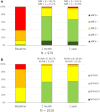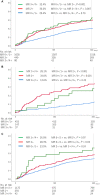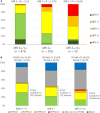One-Year Outcomes and Their Relationship to Residual Mitral Regurgitation After Transcatheter Edge-to-Edge Repair With MitraClip Device: Insights From the OCEAN-Mitral Registry
- PMID: 37815039
- PMCID: PMC10757540
- DOI: 10.1161/JAHA.123.030747
One-Year Outcomes and Their Relationship to Residual Mitral Regurgitation After Transcatheter Edge-to-Edge Repair With MitraClip Device: Insights From the OCEAN-Mitral Registry
Abstract
Background Limited data are available about clinical outcomes and residual mitral regurgitation (MR) after transcatheter edge-to-edge repair in the large Asian-Pacific cohort. Methods and Results From the Optimized Catheter Valvular Intervention (OCEAN-Mitral) registry, a total of 2150 patients (primary cause of 34.6%) undergoing transcatheter edge-to-edge repair were analyzed and classified into 3 groups according to the residual MR severity at discharge: MR 0+/1+, 2+, and 3+/4+. The mortality and heart failure hospitalization rates at 1 year were 12.3% and 15.0%, respectively. Both MR and symptomatic improvement were sustained at 1 year with MR ≤2+ in 94.1% of patients and New York Heart Association functional class I/II in 95.0% of patients. Compared with residual MR 0+/1+ (20.4%) at discharge, both residual MR 2+ (30.2%; P < 0.001) and 3+/4+ (32.4%; P = 0.007) were associated with the higher incidence of death or heart failure hospitalization (adjusted hazard ratio [HR], 1.59; P < 0.001, and adjusted HR, 1.73; P = 0.008). New York Heart Association class III/IV at 1 year was more common in the MR 3+/4+ group (20.0%) than in the MR 0+/1+ (4.6%; P < 0.001) and MR 2+ (6.4%; P < 0.001) groups, and the proportion of New York Heart Association class I is significantly higher in the MR 1+ group (57.8%) than in the MR 2+ group (48.3%; P = 0.02). Conclusions The OCEAN-Mitral registry demonstrated favorable clinical outcomes and sustained MR reduction at 1 year in patients undergoing transcatheter edge-to-edge repair. Both residual MR 2+ and 3+/4+ after transcatheter edge-to-edge repair at discharge were associated with worse clinical outcomes compared with residual MR 0+/1+. Registration Information https://upload.umin.ac.jp. Identifier: UMIN000023653.
Keywords: edge‐to‐edge repair; mitral regurgitation; structural heart disease.
Figures




Comment in
-
Optimizing Transcatheter Edge-to-Edge Repair of the Mitral Valve: The Relentless Pursuit of Perfection.J Am Heart Assoc. 2023 Oct 17;12(20):e031874. doi: 10.1161/JAHA.123.031874. Epub 2023 Oct 10. J Am Heart Assoc. 2023. PMID: 37815043 Free PMC article. No abstract available.
References
-
- Agricola E, Ielasi A, Oppizzi M, Faggiano P, Ferri L, Calabrese A, Vizzardi E, Alfieri O, Margonato A. Long‐term prognosis of medically treated patients with functional mitral regurgitation and left ventricular dysfunction. Eur J Heart Fail. 2009;11:581–587. doi: 10.1093/eurjhf/hfp051 - DOI - PubMed
Publication types
MeSH terms
LinkOut - more resources
Full Text Sources
Medical

